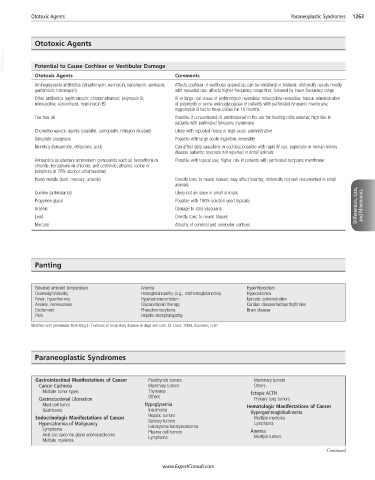Page 2524 - Cote clinical veterinary advisor dogs and cats 4th
P. 2524
Ototoxic Agents Paraneoplastic Syndromes 1263
Ototoxic Agents
VetBooks.ir Potential to Cause Cochlear or Vestibular Damage
Ototoxic Agents Comments
Aminoglycoside antibiotics (streptomycin, neomycin, kanamycin, amikacin, Affects cochlear or vestibular apparatus; can be unilateral or bilateral; ototoxicity occurs mostly
gentamicin, tobramycin) with repeated use; affects higher-frequency range first, followed by lower-frequency range
Other antibiotics (erythromycin; chloramphenicol; polymyxin B; IV or large oral doses of erythromycin reversible; minocycline reversible; topical administration
minocycline; vancomycin, hygromycin B) of polymyxin or some aminoglycosides in patients with perforated tympanic membrane;
hygromycin B fed to three collies for 10 months
Tea tree oil Possible if concentrated oil administered in the ear for treating otitis externa; high risk in
patients with perforated tympanic membrane
Chemotherapeutic agents (cisplatin, carboplatin, nitrogen mustard) Likely with repeated doses or high acute administration
Salicylate analgesics Possible with large acute ingestion; reversible
Diuretics (furosemide, ethacrynic acid) Can affect stria vascularis in cochlea; possible with rapid IV use, especially in human kidney
disease patients; toxicosis not reported in small animals
Antiseptics (quaternary ammonium compounds such as benzethonium Possible with topical use; higher risk in patients with perforated tympanic membrane
chloride, benzalkonium chloride, and cetrimide; ethanol, iodine or
iodophors in 70% alcohol; chlorhexidine)
Heavy metals (lead, mercury, arsenic) Directly toxic to neural tissues; may affect hearing; ototoxicity not well documented in small
animals
Quinine (antimalarial) Likely not an issue in small animals
Propylene glycol Possible with 100% solution used topically
Arsenic Damage to stria vascularis Differentials, Lists, Differentials, Lists, and Mnemonics and Mnemonics
Lead Directly toxic to neural tissues
Mercury Atrophy of cerebral and cerebellar cortices
Panting
Elevated ambient temperature Anemia Hyperthyroidism
Overweight/obesity Hemoglobinopathy (e.g., methemoglobinemia) Hypocalcemia
Fever, hyperthermia Hyperadrenocorticism Narcotic administration
Anxiety, nervousness Glucocorticoid therapy Cardiac disease/tachyarrhythmias
Excitement Pheochromocytoma Brain disease
Pain Hepatic encephalopathy
Modified with permission from King L: Textbook of respiratory disease in dogs and cats, St. Louis, 2004, Saunders, p 47.
Paraneoplastic Syndromes
Gastrointestinal Manifestations of Cancer Parathyroid tumors Mammary tumors
Cancer Cachexia Mammary tumors Others
Multiple tumor types Thymoma Ectopic ACTH
Gastroduodenal Ulceration Others Primary lung tumors
Mast cell tumor Hypoglycemia Hematologic Manifestations of Cancer
Gastrinoma Insulinoma Hypergammaglobulinemia
Endocrinologic Manifestations of Cancer Hepatic tumors Multiple myeloma
Hypercalcemia of Malignancy Salivary tumors Lymphoma
Lymphoma Leiomyoma/leiomyosarcoma Anemia
Anal sac apocrine gland adenocarcinoma Plasma cell tumors Multiple tumors
Multiple myeloma Lymphoma
Continued
www.ExpertConsult.com
www
.ExpertConsult.com

